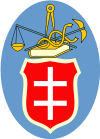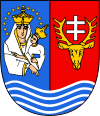Leżajsk
| Leżajsk | ||
|---|---|---|
|
Town Hall and market square | ||
| ||
 Leżajsk | ||
| Coordinates: 50°16′N 22°26′E / 50.267°N 22.433°E | ||
| Country | Poland | |
| Voivodeship |
| |
| County |
| |
| Gmina | Leżajsk (urban gmina) | |
| Government | ||
| • Mayor | Ireneusz Stefański | |
| Area | ||
| • Total | 20.29 km2 (7.83 sq mi) | |
| Population (2011) | ||
| • Total | 14,507 | |
| • Density | 710/km2 (1,900/sq mi) | |
| Time zone | CET (UTC+1) | |
| • Summer (DST) | CEST (UTC+2) | |
| Postal code | 37-300 | |
| Car plates | RLE | |
| Website | http://www.miastolezajsk.pl | |
Leżajsk [ˈlɛʐai̯sk] (full name The Free Royal City of Leżajsk, Polish: Wolne Królewskie Miasto Leżajsk; Ukrainian: Лежайськ, Lezhais’k; Yiddish: ליזשענסק-Lizhensk) is a town in southeastern Poland with 14,507 inhabitants.[1] It has been situated in the Subcarpathian Voivodship since 1999 and is the capital of Leżajsk County.
Leżajsk is famed for its Bernadine basilica and monastery, built by the architect Antonio Pellacini. The basilica contains a highly regarded pipe organ from the second half of the 17th century and organ recitals take place there. It stands as one of Poland's official national Historic Monuments (Pomnik historii), as designated April 20, 2005, and tracked by the National Heritage Board of Poland.
Leżajsk is also home of the Leżajsk brewery. The Jewish cemetery in Leżajsk is a place of pilgrimage for Jews from all over the world, who come to visit the tomb of Elimelech, the great 18th century Hasidic Rebbe.[2] The town is crossed by a forest creek ‘Jagoda’.
History
Lezajsk, which is part of historic Red Ruthenia, was first mentioned in 1346 and granted town charter on December 28, 1397 by King Wladyslaw Jagiello. In 1409, a Roman Catholic parish was established here, and since 1439, the parish was operated by monks of the Order of the Holy Sepulchre from Miechów, who built their abbey in Lezajsk. In 1424, Lezajsk became seat of a starosta; at that time the town belonged to the powerful Jaroslawski family (Leliwa coat of arms).
The development of Lezajsk was slow, due to numerous and devastating Tatar and Wallachian raids, which took place in 1498, 1500, 1509, 1519 and 1524. Following these raids, Polish kings granted several privileges to the looted town, and finally, on September 23, 1524 in Lwow, King Zygmunt Stary decided to move Lezajsk to a new location, which was easier to defend. The town was moved some 5 kilometers south-west, and its new name was Lezajsk Zygmuntowski. During the reign of Zygmunt August, Lezajsk prospered due to protection of its starosta, Krzysztof Szydlowiecki (Odrowaz coat of arms), who was Crown Chancellor. In 1608, Bernadine monks from nearby Przeworsk were brought to Lezajsk by Bishop of Przemyśl, Maciej Pstrokonski, and two years later, first brick church was built. In 1624 Lezajsk was looted and burned by Crimean Tatars, Swedish invasion of Poland (1655 - 1660) brought more destruction.
Following the first partition of Poland (1772), Lezajsk was annexed by the Habsburg Empire, and remained in Austrian Galicia until November 1918. In 1809, the town was captured by the Duchy of Warsaw, but soon afterwards, it was retaken by Austrians. In 1896-1900, a rail line connecting Lezajsk with Przeworsk and Rozwadow was completed. The town suffered during World War One, as Austro-Hungarian and Russian armies fought here in 1914 and 1915. Lezajsk was occupied by Russians between November 1914 and May 1915.
In the Second Polish Republic, Lezajsk belonged to Lwow Voivodeship. In July 1929, the town was visited by President Ignacy Moscicki. On September 13, 1939, Lezajsk was captured by the Wehrmacht. During World War Two, the Home Army was very active in the area, and on May 28, 1943, Germans shot 43 residents of the town. Lezajsk was captured by the Home Army on July 27, 1944.
Gallery
 The façade of the basilica
The façade of the basilica The famous organ in the basilica
The famous organ in the basilica Leżajsk museum
Leżajsk museum Basilica and Bernardine Convent
Basilica and Bernardine Convent Historic Orthodox church
Historic Orthodox church
Historical Sites
- The Holy Trinity and All Saints' Parish Church
- The Bernardine Order Monastery and Church Complex
- The Former Greek Catholic Parish Church under the invocation of Holy Virgin's Rest, currently known as the Succursal Roman Catholic Church
- The Jewish Cemetery at Górna Street, established in the 18th century. In the cemetery is the tomb of Rabbi Elimelech Weissblum.
- The Town Hall, 1 Rynek Street
- The Arsenal, Furgalskiego Street, the 19th century
- The Municipal Public Library. The library was erected before 1914 as a social and culture club of the "Proświta" Ukrainian Association, and has functioned as the library since 1956.
- The Former Palace, 4 Furgalskiego Street
Notable people
- Rabbi Elimelech Weisblum (1717–1787), one of the Hasidic movement's founding Rebbes.
- Prof. Janusz Dolny, b. December 3, 1927, d. April 16, 2008, a Polish pianist and composer, was born in Kuryłówka, a village in the province of Leżajsk; He studied music at Konserwatorium Krakowskie im. Witolda Lutoslawskiego in Kraków and lived in Kraków.
- Count Jan Potocki (1761–1815), capitan, engineer of the Crown Army, ethnologist, Egyptologist, linguist, and author.
References
- "Leżajsk Official Website".
 (in Polish) © 2003 Urząd Miejski w Leżajsku. Retrieved 2008-10-22.
(in Polish) © 2003 Urząd Miejski w Leżajsku. Retrieved 2008-10-22.
- Notes
- ↑ Demographic Yearbook of Poland 2012
- ↑ "Jewish Cemeteries in Poland". © 2004-2008, translated by Joanna Kołdras, Andrzej Fister-Stoga. Retrieved 2008-11-01.
External links
- Rabbi Elimelech of Lezajsk
- Lezajsk at Polska.pl
- More about Lezajsk
- Lezajskie Opowiesci - Historical events of the last century
- Virtual Tour 360 panoramas taken by Radoslaw Sobik
- View of monastery in Leżajsk from the drone
| Wikimedia Commons has media related to Leżajsk. |
Coordinates: 50°16′N 22°25′E / 50.267°N 22.417°E


